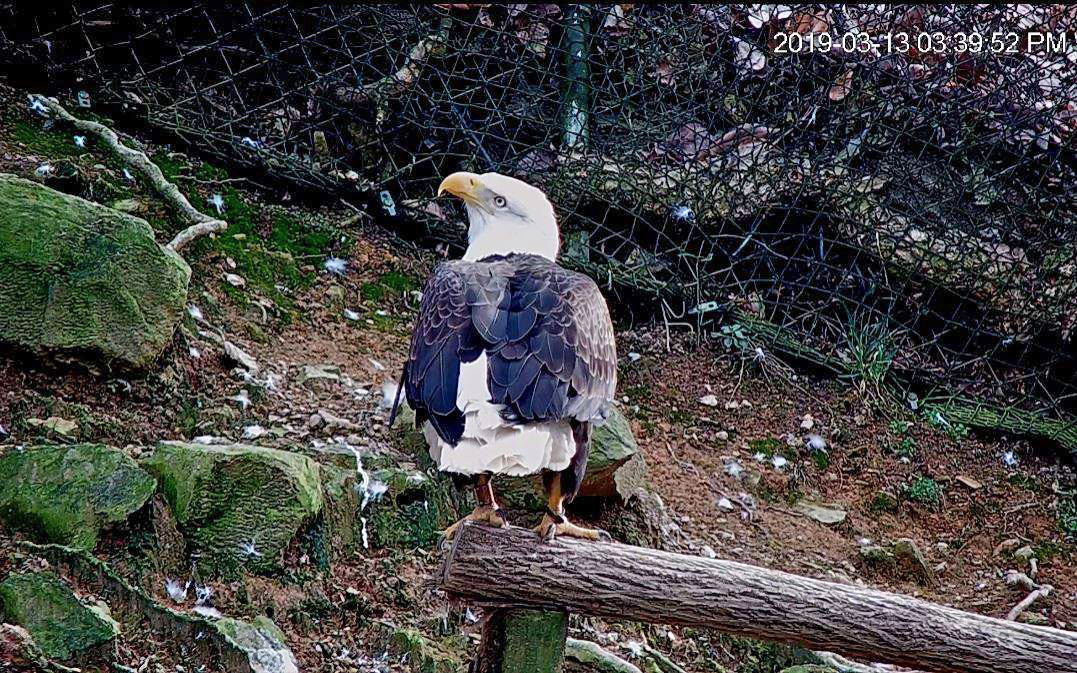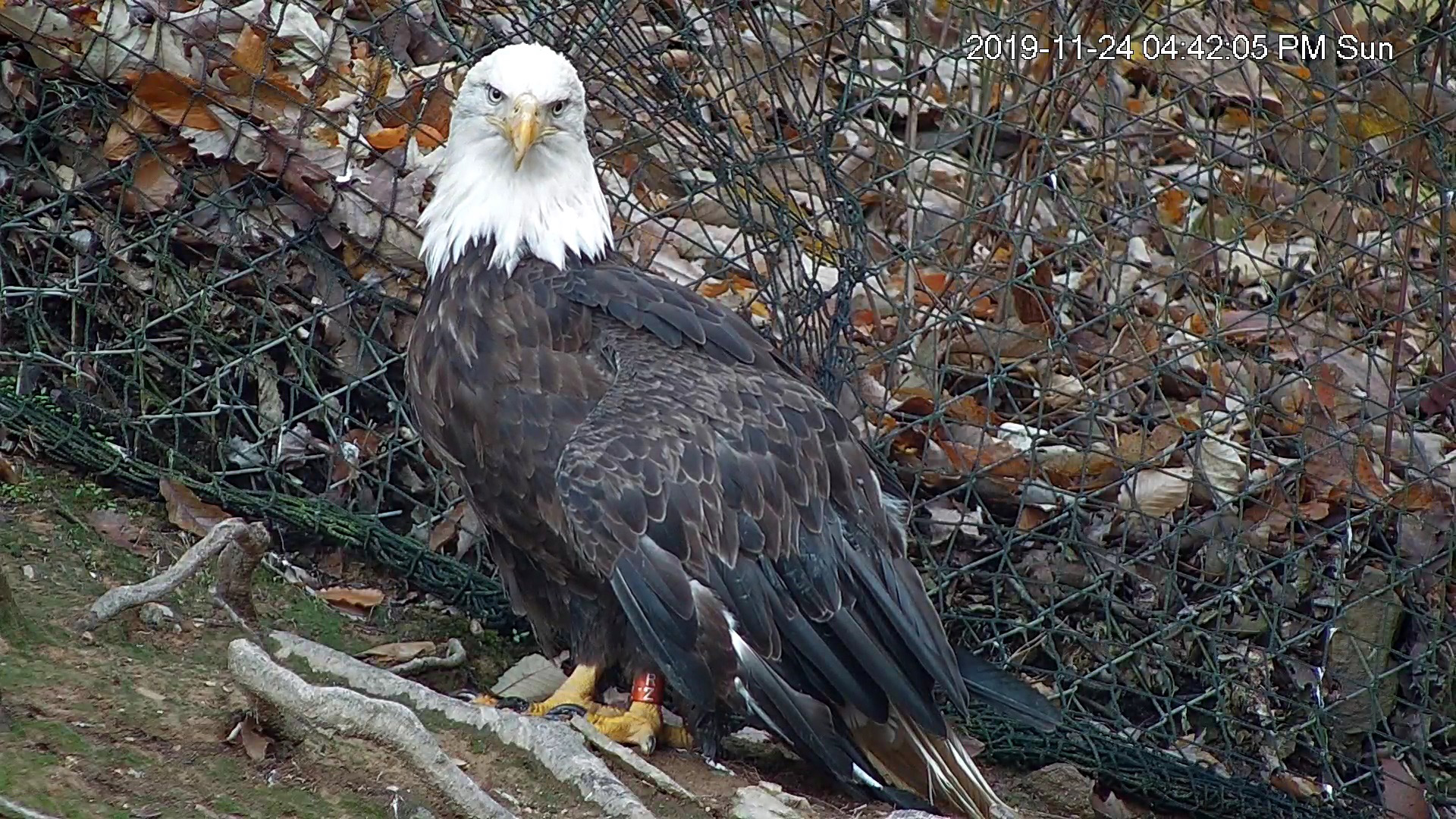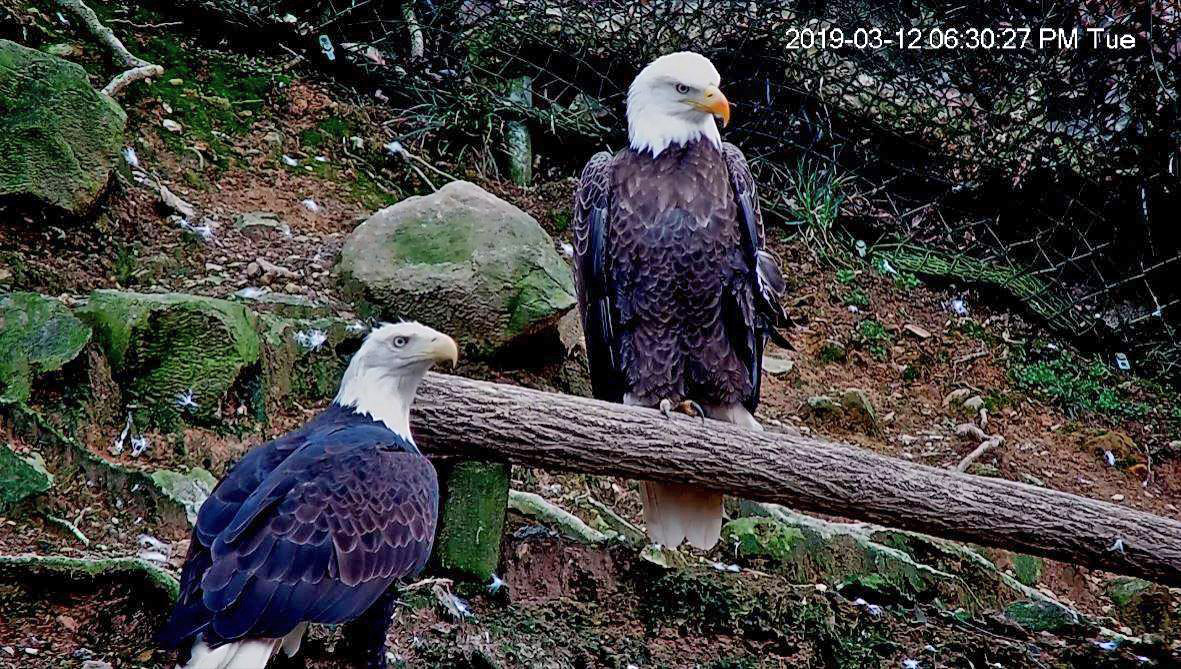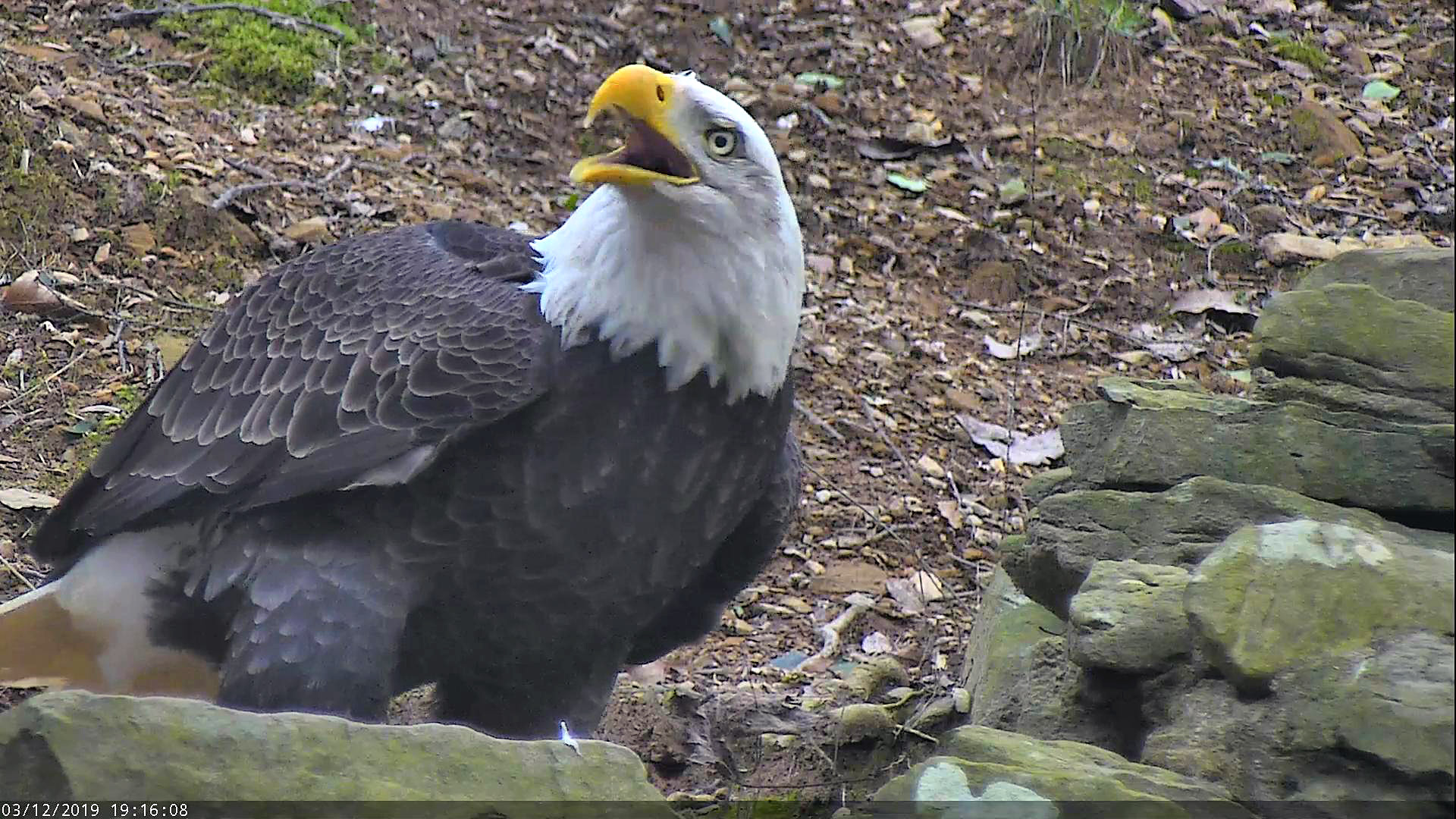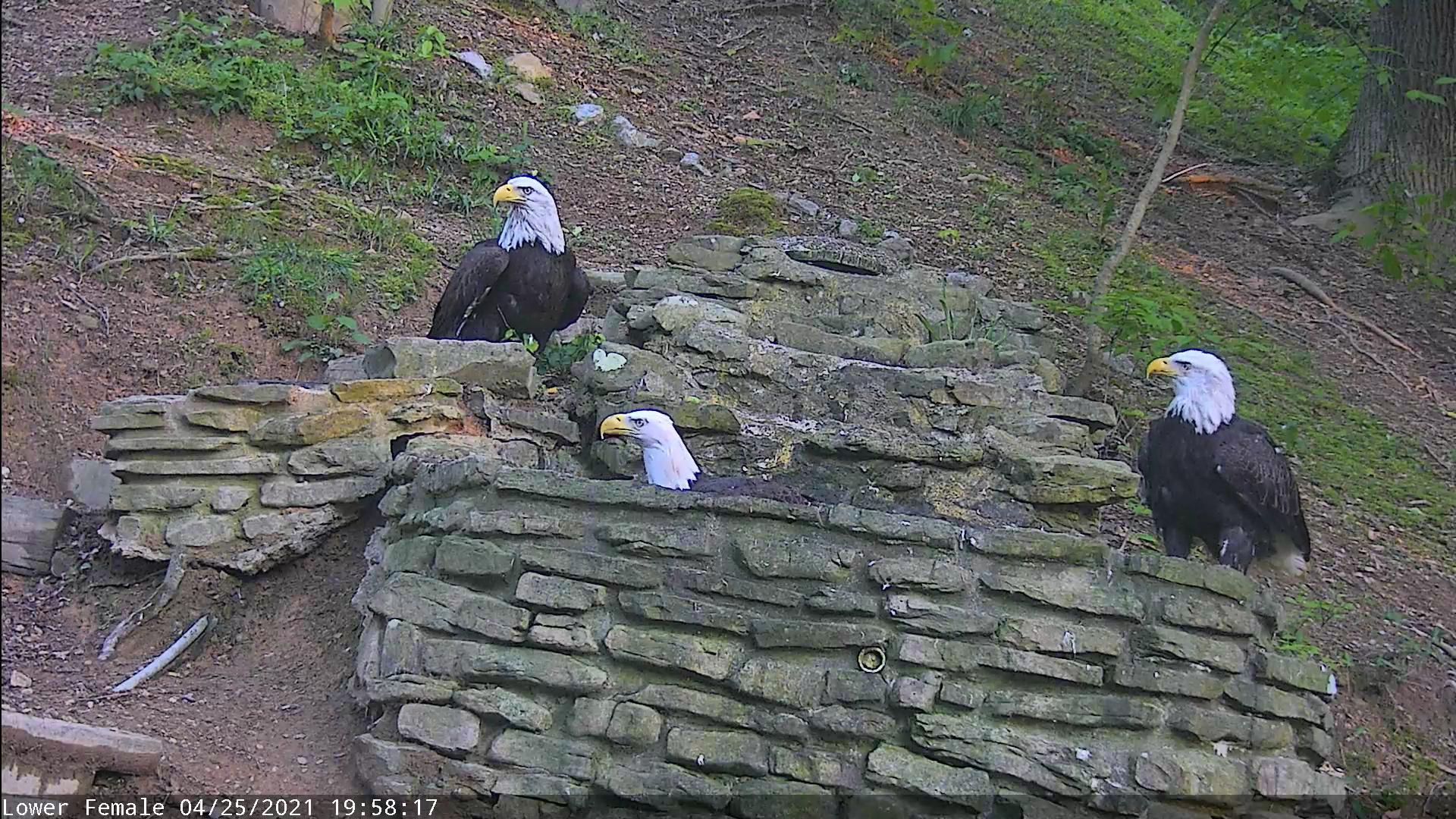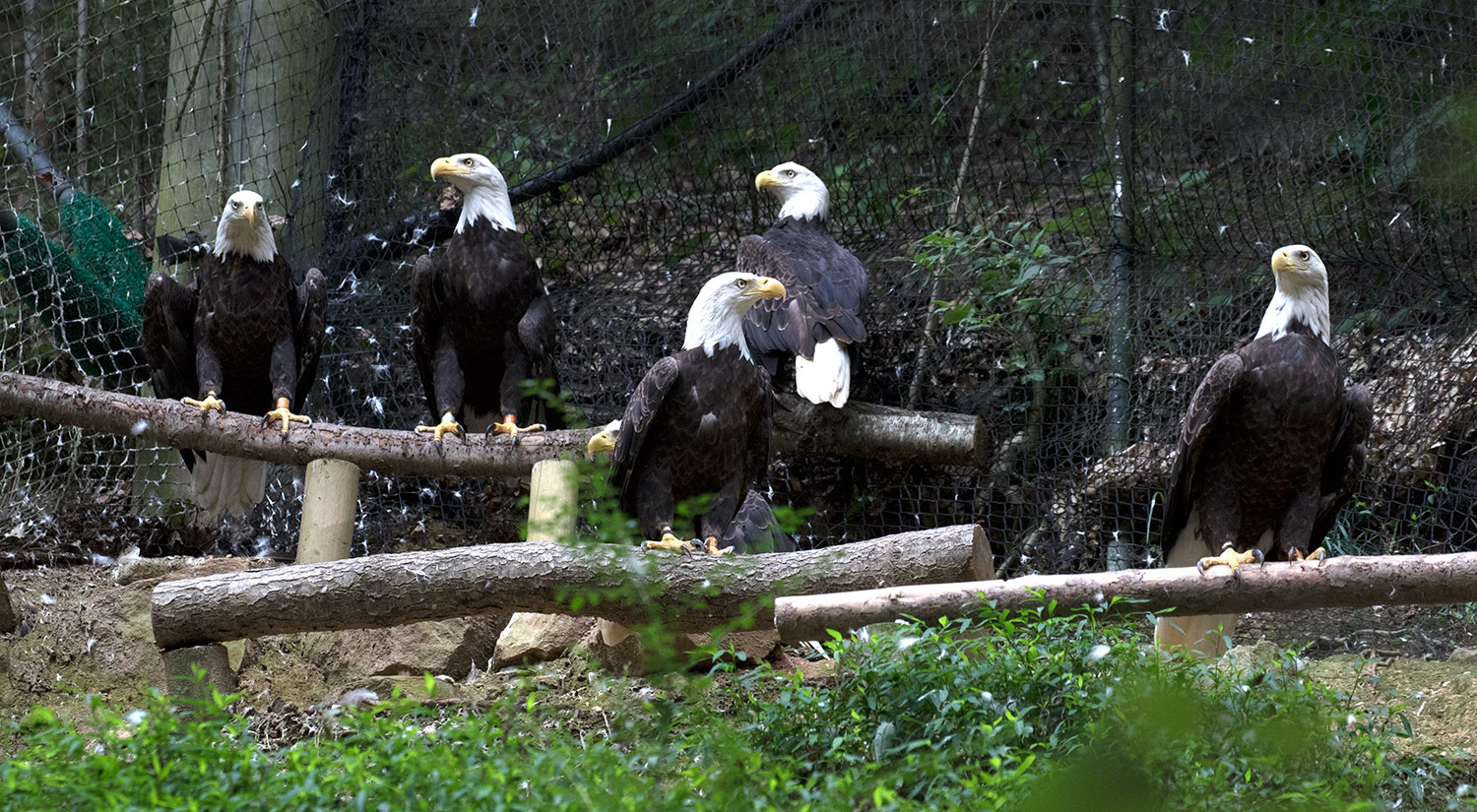Eagle Mountain Sanctuary
Species: Haliaeetus leucocephalus, Bald Eagles • Hatch Year: Varied • Sex: Varied • Disability: Varied
Eagle Mountain Sanctuary encompasses 400,000 cubic feet on the side of a very steep, heavily wooded hillside in the Dollywood theme park. The bald eagles residing within Eagle Mountain Sanctuary are all permanently disabled and would not be able to survive in the wild. These birds are cared for by AEF staff who provide fresh water and food and who visually ensure that the eagles are in good health on a daily basis. Each eagle is given a full physical once a year when their enclosures are inspected and renovated.
Eagle Mountain Sanctuary is divided into four compartments.
Aviary one is dedicated to nesting pair, Honor and Braveheart. The aviary is outfitted with a man-made nesting structure that the pair makes their own with nestorations and natural materials.
Aviary two is home to our female bald eagles with partial flight ability.
Aviary three is home to our male bald eagles with partial flight ability.
The smallest enclosure is located on level ground separate from the main exhibit, and eagles who have little to no flight ability (wing amputations) live in this naturally landscaped enclosure.
These are the residents of Eagle Mountain Sanctuary and a few of their stories:
All photos © American Eagle Foundation.
Amelia
Hatch Year: Unknown
Sex: Female
Disability: Wing Injury
Ankle Band: Orange SU
Origin: Mississippi
Story:
Amelia was transferred to the AEF from the Jackson Zoo in May 2020. In January of 2017 she arrived at Wild at Heart Rescue in Mississippi for rehab. Amelia had a fracture in her right wing and the tip of that wing was missing. At the time the rehabbers suspected this occurred due to electric shock. Amelia was eventually transferred to the Jackson Zoo for continued rehabilitation and flight conditioning, however she did not regain enough flight ability to be released back into the wild.
Buckeye
Hatch Year: Possibly 2016/2017
Sex: Male
Disability: Damaged feather follicles on right wing and wrist – Damage to feet
Ankle Band #: RE114575 (Black)
Origin: Crows Hollow Wildlife Care (Ohio)
Story:
Buckeye arrived at AEF in 2021, he was estimated to be about 4-5 years old due to his plumage at intake. This bird nearly drowned in a lake hanging on to a too- large fish. He then let go and swam to a dock where he used his wings to try and climb out of the water. Construction workers got him out and wildlife officer rescued him. He was very bruised and he could not fly.
After healing from the bruising, he failed to grow primaries beyond about 6” growth at which time the feathers would drop out. With wildlife and falconry recommendations, Crows Hollow let him go through another molt. Again, each time he would grow 3-4 of the primaries, they would molt back out. He is able to fly pretty well actually with his 1.5 wings but he does not get enough lift to fly above about 10’ high nor would he have sustained flight or soaring capabilities.

Faithful Spirit
Hatch Year: 1990
Sex: Female
Disability: Human Socialized
Ankle Band #: RM
Origin: San Francisco, California
Story:
Faithful Spirit was bonded to another non-releasable Bald Eagle named Freedom and they both lived in a large private aviary at the AEF. They hatched and raised numerous young as a part of the AEF’s Captive Breeding and Hacking programs.
Unfortunately, Freedom passed away in 2020. Faithful Spirit was moved to the female section of EMS to reside with our other non-releasable Bald Eagles.
This pair was already bonded when they were transferred to the American Eagle Foundation from the San Francisco Zoo in 2007. In a ceremony honoring fallen soldiers, these two Eagles, along with three other non-releasable Bald Eagle breeding pairs were named by the families of these brave soldiers.
Freedom was named in honor of Sgt. Paul Thomason. Faithful Spirit was named in honor of Sgt. Daniel Morris.
Fiona
Hatch Year: Unknown
Sex: Female
Disability: Wing Injury
Ankle Band: Orange SD
Origin: Arkansas
Story:
Fiona arrived at the AEF in March 2020. She was transferred from the Southwest Veterinary Hospital in Arkansas. Fiona has limited range of motion in her right wing as a result of a metacarpal fracture. Due to her injury Fiona does not have enough flight ability to be released back into the wild.
Glenda
Hatch Year: Unknown
Sex: Female
Disability: Fracture close to left elbow; arthritis in same elbow
Ankle Band #: RS (Orange)
Origin: Washington
Story:
Glenda could write a book about her many adventures before she arrived at AEF.
In June of 2012, in Spokane, WA, Glenda was found injured and was taken to Washington State University’s Veterinary Hospital raptor program for treatment. It was thought the bird had ingested something very toxic, and the prognosis was grim. She also had a fracture close to the left elbow. Word of the bird’s plight spread quickly from Spokane to the East Coast – becoming so popular that ABC’s Diane Sawyer shared her story with the world in her news broadcast. In November 2012, Glenda was banded and released, but she was found again in August 2013 unable to fly. She arrived at American Eagle Foundation in 2014, and in 2017 she formed a bond with Grant. The pair were given their own aviary, where they had three eaglets, two of which survived.
Grace
Hatch Year: 2002 or 2003
Sex: Female
Disability: Arthritic Shoulder (Poor flight)
Ankle Band #: PX (Orange)
Origin: Maryland
Story:
Grace formally known as Boots went to the Wildfowl Trust of North America (WTNA) in May 2003 from the Baltimore Zoo hospital. She was a first year eagle when she had been found down on the ground with such bad arthritis in both shoulders that she was not able to get more than a 5 foot lift or sustain flight beyond 50 feet. She had maintained a healthy weight and no other medical problems until after March 2006. In July 2006 she was sent to Wildlife Rescue in Maryland after a volunteer noticed she “looked bad.” Upon arrival she was found with massive weight loss, anemia, bilateral bumble foot, internal and external parasites (feather mites/lice), and a massive abrasion of her cere that was infected. These were successfully treated over the next 6 months and she was sent back to the WTNA with a healthy weight. In April 2007, she was returned to Wildlife Rescue again with weight loss, anemia, bilateral bumble foot, and a massive infected abrasion of her cere. Her demeanor was depressed. Six months later she completely recovered and she, along with another male Bald Eagle from Wildlife Rescue, were transferred to the American Eagle Foundation to be placed into Eagle Mountain Sanctuary.
Hamilton
Hatch Year: Unknown
Sex: Male
Disability: Left Wing Injury as a result of possible gunshot wound
Ankle Band #: RE (Orange)
Origin: Hamblen County, TN
Story:
Hamilton came to the AEF as an adult Bald Eagle. He was brought to the University of Tennessee Avian and Zoological Medicine on March 28th 2013 after being found in Hamblen County, TN. Physical examination and radiographs revealed a chronic fracture of the left ulna with some involvement of the elbow joint. Four pellets were noted within the body suggesting that the eagle may have been a gunshot victim. The Eagle was transferred to the American Eagle Foundation the following day, and then returned to UT on 24 May 2013 for reevaluation of the left wing and elbow joint, which appeared swollen. The joint contained a significant amount of fluid, some of which was aspirated and submitted for culture. The Eagle received medications for pain relief and antibiotics pending culture results, and returned again on 10 October 2013 for evaluation of the left wing. Again fluid was present within the joint. Radiographs confirmed swelling of the joint but also indicated damage to the radial and humeral bones at the joint and degenerative joint disease of the elbow. Repeat culture of the joint fluid did not reveal any bacteria. Subsequent to the recheck examination the joint appeared to be less swollen. Although Hamilton can fly, the chronic nature and severity of his joint disease made him an extremely poor candidate for release with any reasonable expectation that he would survive, thus he was placed permanently into his new home!
Hope
Hatch Year: 2000
Sex: Female
Disability: Wing Injury
Ankle Band #: RD Orange
Origin: Boise, Idaho
Story:
Hope came to the American Eagle Foundation at approximately one year of age from the Tish Raptor Rehab Center of Boise Idaho. This young Eagle had been found injured and taken there for help. Her wing had broken between the elbow and shoulder and an operation was performed to hold it together. The break was very bad and she was not expected to recover. She had many complications and eventually was brought to The American Eagle Foundation (AEF) in June of 2001. Dr. Ryan, a veterinarian used by the AEF, had to perform another operation to replace the pin in her wing. Hope had a rough convalescence over a period of several months and it was uncertain if she would live. Due to the severity of her injury and extended recovery, she was deemed permanently disabled and could not fly or survive in the wild.
The name, Hope, symbolizes the struggles, which can be overcome, even when the odds are against you.
Josephine
Hatch Year: 2018 – 2019
Sex: Female
Disability: Left Wing Injury
Ankle Band #:
Origin: Gilmer County, West Virginia
Story:
Josephine was found hopping around in a creek. She sustained an injury to her left wing at both her ulna and radius- causing her to lose complete capability of flying.
She was transferred to AEF in 2021 for her forever home from Avian Conservation Center of Appalachia, our friends at ACCA tell us she loves fish heads, lots of space, and her traveling playlist included some hits from Dolly Parton.
Named in loving honor & memory of Walter Crain who served in WWII.
Kathy
Hatch Year: Unknown
Sex: Female
Disability: Injury to Left Patagium (limited range of motion)
Ankle Band #: PU (Orange)
Origin: Wildlife Center of Virginia
Story:
Kathy was admitted to the Wildlife Center as an adult on February 9th, 2007. On initial presentation, the bird had a large open laceration on the left patagium; the membrane on the leading edge of the wing. The wound healed, however, as a result of the injury the patagial ligament has constricted thus restricting full range of motion on the left wing. She was transferred to the American Eagle Foundation to live in her new home at Eagle Mountain Sanctuary. She recovered well and, despite her limited flight ability, is very strong and feisty!
King George
Hatch Year: Unknown
Sex: Male
Disability: Left Wing-tip Injury
Ankle Band #: RX (Orange)
Origin: Wildlife Center of Virginia
King George came to us in September 2015 as an adult from Wildlife Center of Virginia. He was found injured on August 2nd, 2013 in King George County, Virginia. Due to a traumatic event, his left wing tip was partially amputated, resulting in impaired flight ability.
Kodak
Hatch Year: Unknown
Sex: Male
Disability: Left wing dislocation
Ankle Band #: None
Origin: Kodak, TN
Kodak was found in a cow field in Kodak, TN.
Unable to fly, he was found by some farmers in December of 2020. Kodak not only had a left carpal dislocation, he also tested positive for lead poisoning. After rehabilitation within our flight run – he still was unable to fly well enough to hunt for himself.
Riley
Hatch Year: Unknown
Sex: Male
Disability: Left Wing Injury
Ankle Band #: NA
Origin: West Virginia
Story:
This male arrived at Avian Conservation Center of Appalachia in 2014 after sustaining an injury to his left wing. He suffered a fracture to both his ulna and radius- causing him to lose complete capability of flying. While a home was being located, he served as a mentor to other young eagles that came in. Because of this eagle, the nestlings learned from him, and did not imprint on their human caregivers giving them a second chance in the wild.
Named in loving honor and memory of Raymond Walter Michalik who served in the Korean War, stationed in France and Germany
Mr. Roosevelt (“Roo”)
Hatch Year: Unknown
Sex: Male
Disability: Injuries to left foot and elbow.
Ankle Band #: RB (Orange)
Origin: Arkansas
Story:
Mr. Roosevelt was presented to the American Eagle Foundation and subsequently to the University of Tennessee Veterinary Medical Center on June 2, 2011 for evaluation. Mr. Roosevelt originated in Arkansas and the rehabilitator there believed that the Eagle was non-releasable. The veterinarian’s examination revealed injuries to the left foot, wrist and elbow. Injuries to the foot and wrist were resolved, but the elbow became a chronic problem. Roo was treated several times with antibiotics and the joint improved; however, it became apparent that he wouldn’t be able to fly well enough to be released back into the wild and was transferred to American Eagle Foundation November 2011.
In 2016, the American Eagle Foundation found two eggs that were laid on the ground in Eagle Mountain Sanctuary, and the eggs were taken to the American Eagle Foundation’s incubation room. One eaglet hatched but unfortunately didn’t make it past its second week.
Later that year, the pair was moved into its own breeding enclosure with its own manmade nest in order to properly mate and raise young!
In 2017, the pair successfully hatched and raised two eaglets! They became the stars of the Dollywood Eagle Cams project, impressing thousands of viewers with their impressive first-time parenting skills.
Sadly on Jan. 17, 2018, Eleanor (Ellie) was found deceased from unknown causes in the aviary.
Scarlet
Hatch Year: Unknown
Sex: Female
Disability: Right wing nerve damage
Ankle Band #: RE114574 (Black)
Origin: Crows Hollow Wildlife Care (Ohio)
Story:
Scarlet was found in a corn field by wildlife officer, she was feeding on a discarded pig carcass. Scarlet sustained a right wing injury from a possible collision with a car resulting in radial nerve damage to right wrist. For a period of time she had a severe right wing droop and she had to make an effort to fold it up. With extensive physical therapy she has regained enough wing strength for short flights and can fold the wing in 90% proper position with no damage to primaries. She has very little to no sustained flight or capabilities of soaring.
Virginia
Hatch Year: Unknown
Sex: Female
Disability: Abnormal Feather Growth (inhibited flight)
Ankle Band #: PV (Orange)
Origin: Wildlife Center of Virginia
Story:
Virginia experienced permanent injuries which prevented its release back into the wild. This bird was admitted to the Wildlife Center of Virginia on May 18, 2010 after being seen running through a field unable to fly. On initial physical exam and radiographs there were no abnormalities found with the exception of many broken feathers on the right wing. It was given time to grow feathers, however the feathers remained abnormal on the right wing. Bacterial and fungal cultures were performed of the feather follicles, as well as systemic blood work and multiple repeat physical exams and radiographs. No abnormalities were evident with the exception of pinched feather follicles appreciated on radiographs and grossly visible when a feather falls out. This could be indicative of a past West Nile Virus infection; however, it is not possible to definitively diagnose this. Due to this abnormal feather growth, the WCVA, Virginia was deemed a non-releasable Eagle, as it is unable to fly well enough to fend for itself in the wild. Virginia was transferred to the American Eagle Foundation in February 2011 and now lives in Eagle Mountain Sanctuary.
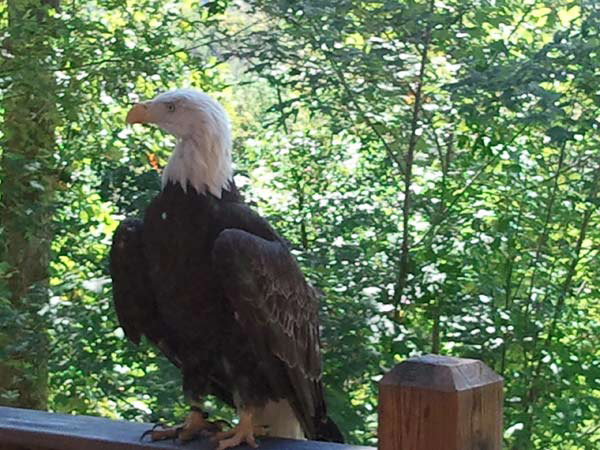
Volunteer
Hatch Year: 1989
Sex: Male
Disability: NA
Ankle Band #: RA (Orange)
Origin: San Francisco Zoo Breeding Program
Story:
Volunteer was transferred to the American Eagle Foundation from the San Francisco Zoo’s captive breeding program in 2007 as part of a mated pair. Sadly, his mate, Hero, passed away in 2024, after which Volunteer was placed with the other birds on EMS. In a ceremony honoring fallen soldiers, Volunteer and Hero were named by a family in memory of Army National Guard soldier Joey Hunt.
During their time together, Volunteer and Hero hatched numerous eaglets that were placed into wild nests on the Channel Islands as part of a bald eagle recovery project off the coast of Los Angeles. The San Francisco Zoo later concluded its highly successful breeding program after helping reintroduce more than 100 young bald eagles into the wild.
ABOUT THIS SPECIES
Bald Eagles were placed at the center of the Great Seal of the United States in 1782! Since then, they have served as the pride of America’s skies and the symbol of all that America stands for.
Bald Eagles obviously aren’t bald! “Bald” in this sense refers to an Middle English word that means “white headed.” When eagles fledge the nest at between 10 and 13 weeks of age, they are primarily all brown. An Eagle gets its full white head and tail feathers and yellow beak and eyes at around four to five years of age.
Bald Eagles typically mate for life. Usually, they will only look for a new mate if their faithful companion dies, but sometimes a new mate is chosen in a territorial fight over a nest.
In building a nest, Bald Eagles will choose a ‘super-canopy’ tree—one rising above the rest— near to water, with sturdy limbs and a commanding view of the surrounding terrain. Typical nest heights are 50-125 feet high. They make use of twigs, grasses, soft mosses and feathers in making their nests and normally return to the same nest each year during breeding season and add new materials to it. A new eagle pair’s nest usually measures about five feet in width and two feet in depth. As they add to it year after year, however, it can reach widths of over ten feet and weigh up to a ton or more. On the Channel Islands, where large trees are very scarce, Bald Eagles have built their nests on cliffs; and, in some coastal areas of Alaska and Canada where there are few tall trees, Bald Eagles will nest on the ground, using whatever materials are available.


